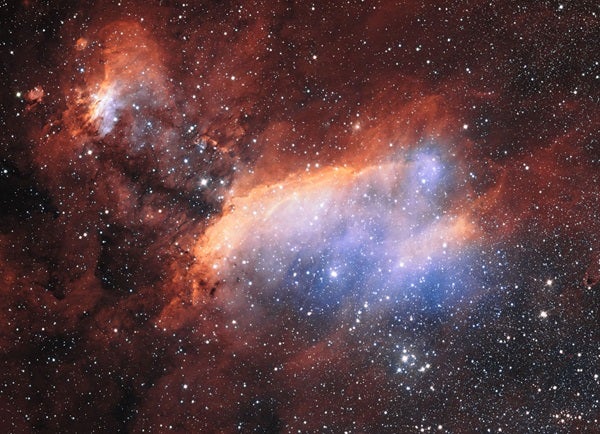Located around 6,000 light-years from Earth in the constellation of Scorpius the Scorpion, the nebula is a huge region filled with gas and clumps of dark dust. These gas clouds are star-forming regions, producing brilliant hot young stars. In visible light, these stars appear as a blue-white color, but they also emit intense radiation in other parts of the spectrum — most notably in the ultraviolet.
It is this ultraviolet light from the stars that causes the gas clouds to glow. This radiation strips electrons from hydrogen atoms, which then later recombine and release energy in the form of light. Each chemical element emits light at characteristic colors when this process occurs, and for hydrogen the predominant color is red. IC 4628 is an example of an HII region.
The Prawn Nebula is around 250 light-years across, covering an area of sky equivalent to four times that of the Full Moon. Despite this huge size it has been often overlooked by observers due to its faintness and because most of its light is emitted at wavelengths where the human eye is not sensitive. The nebula is also known as Gum 56, after the Australian astronomer Colin Gum, who published a catalog of HII regions in 1955.
Over the past few million years, this region of sky has formed many stars, both individually and in clusters. There is a large scattered star cluster named Collinder 316 that extends over most of this image. This cluster is a part of a much larger gathering of hot and luminous stars. Also visible are many dark structures, or cavities, where interstellar matter has been blown away by the powerful winds generated by the nearby hot stars.
The VLT Survey Telescope (VST) is the largest telescope in the world designed for surveying the sky in visible light. It is a state-of-the-art 2.6-meter telescope built around the OmegaCAM camera that contains 32 CCD detectors that together create 268-megapixel images.
The picture forms part of a detailed public survey of a large part of the Milky Way called VPHAS+ that is using the power of the VST to search for new objects such as young stars and planetary nebulae. The survey will also provide the best images yet taken of many huge glowing star formation regions, such as the one pictured here.
The very sharp VST images were further enhanced to bring out the color by including additional high quality imaging through other filters taken by Martin Pugh, a skilled amateur astronomer observing from Australia using 32-centimeter and 13-centimeter telescopes.










